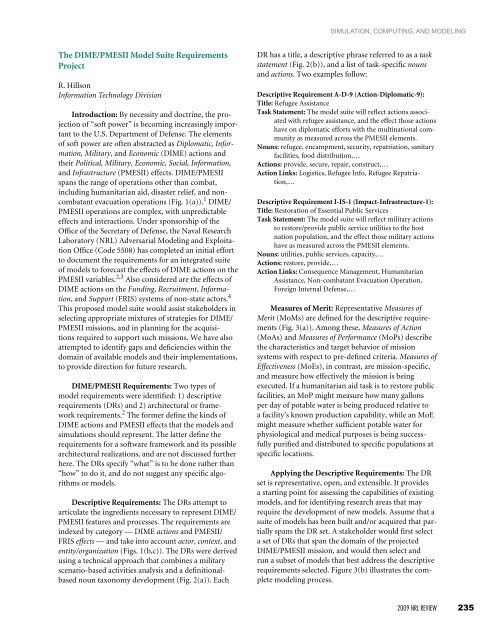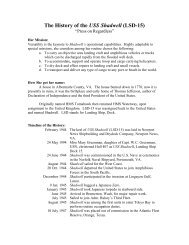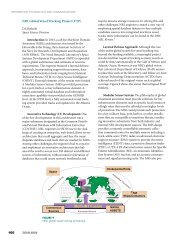The DIME/PMESII Model Suite Requirements Project - Defense ...
The DIME/PMESII Model Suite Requirements Project - Defense ...
The DIME/PMESII Model Suite Requirements Project - Defense ...
You also want an ePaper? Increase the reach of your titles
YUMPU automatically turns print PDFs into web optimized ePapers that Google loves.
<strong>The</strong> <strong>DIME</strong>/<strong>PMESII</strong> <strong>Model</strong> <strong>Suite</strong> <strong>Requirements</strong><br />
<strong>Project</strong><br />
R. Hillson<br />
Information Technology Division<br />
Introduction: By necessity and doctrine, the projection<br />
of “soft power” is becoming increasingly important<br />
to the U.S. Department of <strong>Defense</strong>. <strong>The</strong> elements<br />
of soft power are often abstracted as Diplomatic, Information,<br />
Military, and Economic (<strong>DIME</strong>) actions and<br />
their Political, Military, Economic, Social, Information,<br />
and Infrastructure (<strong>PMESII</strong>) effects. <strong>DIME</strong>/<strong>PMESII</strong><br />
spans the range of operations other than combat,<br />
including humanitarian aid, disaster relief, and noncombatant<br />
evacuation operations (Fig. 1(a)). 1 <strong>DIME</strong>/<br />
<strong>PMESII</strong> operations are complex, with unpredictable<br />
effects and interactions. Under sponsorship of the<br />
Office of the Secretary of <strong>Defense</strong>, the Naval Research<br />
Laboratory (NRL) Adversarial <strong>Model</strong>ing and Exploitation<br />
Office (Code 5508) has completed an initial effort<br />
to document the requirements for an integrated suite<br />
of models to forecast the effects of <strong>DIME</strong> actions on the<br />
<strong>PMESII</strong> variables. 2,3 Also considered are the effects of<br />
<strong>DIME</strong> actions on the Funding, Recruitment, Information,<br />
and Support (FRIS) systems of non-state actors. 4<br />
This proposed model suite would assist stakeholders in<br />
selecting appropriate mixtures of strategies for <strong>DIME</strong>/<br />
<strong>PMESII</strong> missions, and in planning for the acquisitions<br />
required to support such missions. We have also<br />
attempted to identify gaps and deficiencies within the<br />
domain of available models and their implementations,<br />
to provide direction for future research.<br />
<strong>DIME</strong>/<strong>PMESII</strong> <strong>Requirements</strong>: Two types of<br />
model requirements were identified: 1) descriptive<br />
requirements (DRs) and 2) architectural or framework<br />
requirements. 2 <strong>The</strong> former define the kinds of<br />
<strong>DIME</strong> actions and <strong>PMESII</strong> effects that the models and<br />
simulations should represent. <strong>The</strong> latter define the<br />
requirements for a software framework and its possible<br />
architectural realizations, and are not discussed further<br />
here. <strong>The</strong> DRs specify “what” is to be done rather than<br />
“how” to do it, and do not suggest any specific algorithms<br />
or models.<br />
Descriptive <strong>Requirements</strong>: <strong>The</strong> DRs attempt to<br />
articulate the ingredients necessary to represent <strong>DIME</strong>/<br />
<strong>PMESII</strong> features and processes. <strong>The</strong> requirements are<br />
indexed by category — <strong>DIME</strong> actions and <strong>PMESII</strong>/<br />
FRIS effects — and take into account actor, context, and<br />
entity/organization (Figs. 1(b,c)). <strong>The</strong> DRs were derived<br />
using a technical approach that combines a military<br />
scenario-based activities analysis and a definitionalbased<br />
noun taxonomy development (Fig. 2(a)). Each<br />
SIMULATION, COMPUTING, AND MODELING<br />
DR has a title, a descriptive phrase referred to as a task<br />
statement (Fig. 2(b)), and a list of task-specific nouns<br />
and actions. Two examples follow:<br />
Descriptive Requirement A-D-9 (Action-Diplomatic-9):<br />
Title: Refugee Assistance<br />
Task Statement: <strong>The</strong> model suite will reflect actions associated<br />
with refugee assistance, and the effect those actions<br />
have on diplomatic efforts with the multinational community<br />
as measured across the <strong>PMESII</strong> elements.<br />
Nouns: refugee, encampment, security, repatriation, sanitary<br />
facilities, food distribution,…<br />
Actions: provide, secure, repair, construct,…<br />
Action Links: Logistics, Refugee Info, Refugee Repatriation,…<br />
Descriptive Requirement I-IS-1 (Impact-Infrastructure-1):<br />
Title: Restoration of Essential Public Services<br />
Task Statement: <strong>The</strong> model suite will reflect military actions<br />
to restore/provide public service utilities to the host<br />
nation population, and the effect those military actions<br />
have as measured across the <strong>PMESII</strong> elements.<br />
Nouns: utilities, public services, capacity,…<br />
Actions: restore, provide,…<br />
Action Links: Consequence Management, Humanitarian<br />
Assistance, Non-combatant Evacuation Operation,<br />
Foreign Internal <strong>Defense</strong>,…<br />
Measures of Merit: Representative Measures of<br />
Merit (MoMs) are defined for the descriptive requirements<br />
(Fig. 3(a)). Among these, Measures of Action<br />
(MoAs) and Measures of Performance (MoPs) describe<br />
the characteristics and target behavior of mission<br />
systems with respect to pre-defined criteria. Measures of<br />
Effectiveness (MoEs), in contrast, are mission-specific,<br />
and measure how effectively the mission is being<br />
executed. If a humanitarian aid task is to restore public<br />
facilities, an MoP might measure how many gallons<br />
per day of potable water is being produced relative to<br />
a facility’s known production capability, while an MoE<br />
might measure whether sufficient potable water for<br />
physiological and medical purposes is being successfully<br />
purified and distributed to specific populations at<br />
specific locations.<br />
Applying the Descriptive <strong>Requirements</strong>: <strong>The</strong> DR<br />
set is representative, open, and extensible. It provides<br />
a starting point for assessing the capabilities of existing<br />
models, and for identifying research areas that may<br />
require the development of new models. Assume that a<br />
suite of models has been built and/or acquired that partially<br />
spans the DR set. A stakeholder would first select<br />
a set of DRs that span the domain of the projected<br />
<strong>DIME</strong>/<strong>PMESII</strong> mission, and would then select and<br />
run a subset of models that best address the descriptive<br />
requirements selected. Figure 3(b) illustrates the complete<br />
modeling process.<br />
2009 NRL REVIEW 235
SIMULATION, COMPUTING, AND MODELING<br />
236 2009 NRL REVIEW<br />
ENTITIES:<br />
Military<br />
Transnational<br />
Organizations<br />
Non-Governmental<br />
Agencies<br />
Neighbors<br />
Allies<br />
Intra-National Entities<br />
Other US<br />
Governmental<br />
Agencies & Entities<br />
(b)<br />
Humanitarian<br />
Aid / Disaster<br />
Relief<br />
Noncombatant<br />
Evacuation<br />
Operations<br />
Civic<br />
Assistance<br />
ACTORS:<br />
Individuals<br />
Small Groups<br />
Medium-Sized<br />
Groups<br />
Large Groups<br />
Very Large<br />
Groups<br />
CONTEXT:<br />
Time<br />
Location<br />
Environment<br />
<strong>The</strong>ater<br />
Security<br />
Cooperation<br />
(a)<br />
Foreign<br />
Internal<br />
<strong>Defense</strong><br />
Information<br />
Operations<br />
Counterinsurgency<br />
ACTIONS:<br />
Diplomatic<br />
Information<br />
Military<br />
Economic<br />
EFFECTS:<br />
Political<br />
Military<br />
Economic<br />
Social<br />
Infrastructure<br />
Information<br />
EFFECTS:<br />
Funding<br />
Recruitment<br />
Information<br />
Support<br />
FIGURE 1<br />
(a) <strong>DIME</strong> actions and <strong>PMESII</strong> effects span the entire range of military operations other than combat. (b) <strong>DIME</strong>/<br />
<strong>PMESII</strong> may involve both military and non-military entities and actors. (c) In the descriptive requirements developed<br />
for a proposed <strong>DIME</strong>/<strong>PMESII</strong> modeling and simulation suite, the <strong>PMESII</strong> effects have been augmented<br />
by the FRIS effects.<br />
(c)
SIMULATION, COMPUTING, AND MODELING<br />
I. Noun Taxonomy II. Activity Analysis III. Interdependencies<br />
Infrastructure<br />
Utilities<br />
Waste Disposal<br />
Liquid<br />
Solid<br />
Social<br />
Infant Mortality<br />
Food<br />
Water<br />
Health Care<br />
Living Conditions<br />
Military<br />
Law Enforcement<br />
Communications<br />
Stations<br />
Vehicles<br />
Officers<br />
Humanitarian Assistance (HA)<br />
Pave Roads<br />
Install Sewers<br />
Build Sewage Treatment Plants<br />
Collect, Transport, Store Solid Waste<br />
Humanitarian Assistance (HA)<br />
Refurbish Facilities<br />
Hire Doctors<br />
Treat People / Patients<br />
Prevent Disease<br />
(1) A-D-9: (Action-Diplomatic-9):<br />
Title: Refugee Assistance -<br />
A-D-9 Task Statement:<br />
… reflect actions associated<br />
with refugee assistance and<br />
indicate effect actions have<br />
on diplomatic efforts with<br />
multi-national community<br />
across <strong>PMESII</strong> elements.<br />
(2) A-D-10: (Action-Diplomatic-10):<br />
Title: Diplomatic Effect<br />
of Humanitarian Assistance<br />
(3) A-4-4: (Action-Economic-4):<br />
Title: Repatriation<br />
And others ...<br />
Foreign Internal <strong>Defense</strong> (FID)<br />
Provide Security Assistance<br />
Collect and Process Intelligence<br />
Support Combat Operations<br />
Train Host Nation Forces<br />
(a)<br />
ACTIONS IMPACTS<br />
(b)<br />
Waste/Trash Collection<br />
and Disposal<br />
(Lbs Generated - Collected / Time)<br />
(Miles Transported)<br />
Strong, Directional Link<br />
(Interdependency)<br />
Disease Levels<br />
and Transmission<br />
(Disease Type, Percent<br />
Infected)<br />
(Growth / Spreading Rates)<br />
|| No Link ||<br />
Law Enforcement<br />
Personnel<br />
and Activities<br />
(Number of Officers Hired, On<br />
the Street)<br />
(Training Levels, Coverage<br />
(geo and time))<br />
(1) I-IS-1: (Impact-Infrastructure-1):<br />
Title: Restoration of Essential<br />
Public Services -<br />
I-IS-1: Task Statement:<br />
… represent effects of <strong>DIME</strong><br />
actions to restore / provide<br />
public service utilities to<br />
population across the <strong>PMESII</strong><br />
elements.<br />
(2) E-S-4: (Event-Social-4):<br />
Title: Social Impact of Disease:<br />
And others ...<br />
FIGURE 2<br />
(a) Nouns, activities, and interdependencies related to the descriptive requirement I-IS-1 (Impact-Infrastructure-1,<br />
Restoration of Essential Public Services) for two concurrent <strong>DIME</strong>/<strong>PMESII</strong> missions, Humanitarian<br />
Aid (HA) and Foreign Internal <strong>Defense</strong> (FID). Each DR lists Nouns and Actions relevant to the requirement.<br />
Interdependencies may exist between different types of actions. Restoration of Essential Public Services<br />
will affect the Infrastructure, Social structure, and the host nation Military. <strong>The</strong>re is a clear interdependency<br />
between the adequacy of waste disposal and the level of disease, but neither type of activity is linked to law<br />
enforcement. (b) To model a humanitarian aid (HA) mission, simulations must be developed and run that<br />
satisfy diverse descriptive requirements, many of which are interconnected. In this example, three representative<br />
descriptive requirements for modeling HA actions are mapped onto two representative requirements for<br />
modeling the HA impacts.<br />
2009 NRL REVIEW 237
SIMULATION, COMPUTING, AND MODELING<br />
238 2009 NRL REVIEW<br />
Measures of Policy<br />
Effectiveness (MoPEs):<br />
How effective are actions<br />
in advancing national policy?<br />
MoFEs = Are mission<br />
goals satisfied?<br />
MoE = Does MoP<br />
satisfy mission-specific<br />
criteria?<br />
MoPs:<br />
Descriptive<br />
Requirement<br />
Measures<br />
Sub-System<br />
Properties<br />
Input from Analysts and<br />
Subject Matter Experts<br />
(1) Selection of <strong>DIME</strong>/<strong>PMESII</strong><br />
Mission Scenario(s).<br />
(2) Select Descriptive<br />
<strong>Requirements</strong> that encompass<br />
the mission.<br />
(3) Select models that span the<br />
requirements. Add new models<br />
if necessary.<br />
(4) Select and tailor MoMs<br />
(Measures of Merit) for mission<br />
scenario.<br />
(5) Run models; analyze results.<br />
Hierarchies of Measures of Merit (MoMs):<br />
MoPs / MoEs / MoFEs / MoPEs<br />
MoPEs<br />
Measures of Force<br />
Effectiveness (MoFEs)<br />
Measures of Effectiveness (MoEs):<br />
MoP Values / Target Criteria<br />
Measures of Performance (MoPs)<br />
Policy Guidance<br />
Select Scenario<br />
Review Descriptive<br />
<strong>Requirements</strong><br />
Select <strong>Requirements</strong><br />
Select <strong>Model</strong>s<br />
Select and<br />
Parameterize MoMs<br />
“Have our actions created<br />
desirable changes in selected<br />
indicators of political stability?”<br />
Gallons purified water produced per day,<br />
Miles of road constructed per week, etc.<br />
(Historical and/or estimated via analysis or simulation ...)<br />
Dimensional Parameters (DPs) aka<br />
Measures of Action (MoAs)<br />
Units: watts, gallons/unit time, miles per hour, ...<br />
(a)<br />
(b)<br />
“Are the restored<br />
roads now adequate<br />
for x, y, z?”<br />
“Percentage of<br />
roads restored.”<br />
Run <strong>Model</strong>s<br />
Units:<br />
Capacity,<br />
Volume,<br />
Rate<br />
Interpret <strong>Model</strong><br />
Outputs<br />
Present Findings<br />
& Recommendations<br />
FIGURE 3<br />
(a) <strong>The</strong> <strong>DIME</strong>/<strong>PMESII</strong> descriptive requirements include representative Measures of Merit. Measures<br />
of Action (MoAs) and Measures of Performance (MoPs) can be completely defined a priori, but<br />
Measures of Effectiveness (MoEs) are mission-specific, and cannot be completely defined in advance<br />
of the mission specification. (b) <strong>The</strong> <strong>DIME</strong>/<strong>PMESII</strong>-FRIS modeling process.
Gaps and Deficiencies: Hundreds of <strong>DIME</strong>/<br />
<strong>PMESII</strong> models exist. In this study, we were able to<br />
contrast and compare the properties of a small subset<br />
of existing models against the descriptive requirements<br />
and the framework requirements. 2 We provisionally<br />
identified certain gaps and deficiencies in the current<br />
model domain, although we did not attempt to rank<br />
these. Notable gaps include the following:<br />
Lack of model integration scheme. Integration of<br />
several models is required to richly represent the complexity<br />
and interdependencies of the <strong>DIME</strong>/<strong>PMESII</strong><br />
problem space. Each model may have its own formats<br />
for internal data representation, but the models must<br />
be capable of exchanging diverse data types transparently,<br />
while interpreting the data accurately within each<br />
model. To facilitate this, flexible middleware capable of<br />
bridging together any arbitrary collection of models is<br />
required.<br />
Absence of models that cover the full range of military<br />
activities (Fig. 1(a)). <strong>The</strong> military operations that<br />
are typically modeled represent the realm of conflict.<br />
<strong>Model</strong>ing of other specific operations such as the effectiveness<br />
of the training of host nation security forces<br />
by U.S. military personnel, or the effects of U.S. operations<br />
to provide for infrastructure security are currently<br />
not modeled.<br />
Lack of “return on investment” (ROI) assessment.<br />
Current <strong>DIME</strong>/<strong>PMESII</strong> models provide sophisticated<br />
projections of “possible futures.” What is lacking is a<br />
model, or methods, that will permit us to confidently<br />
relate these possible futures to quantitative predicted<br />
changes in indicators that are historically correlated<br />
with desirable outcomes — for example, increases in<br />
the legitimacy and effectiveness of a host nation’s government<br />
performance. 5 This capability would permit<br />
us to compare the relative cost effectiveness of different<br />
proposed combinations of <strong>DIME</strong> actions, while allowing<br />
for constraints imposed by budget, schedule, and<br />
mission. In summary, a complete ROI approach would<br />
let us design experiments to (1) systematically alter<br />
different combinations of model input parameters and<br />
(2) observe the correlations, both positive and negative,<br />
in the contingent forecasts (possible futures) in the<br />
solution space.<br />
Summary: <strong>The</strong> U.S. military is playing an increasing<br />
role as a co-provider of humanitarian aid and<br />
civic services, as well as being tasked with additional<br />
non-combat roles in support of national policy. NRL<br />
has written top-level requirements for the development<br />
of an integrated suite of <strong>DIME</strong>/PMSEII models<br />
to assist in planning these kinds of missions. This work<br />
has resulted in descriptive requirements, framework<br />
requirements, a comparison of a small set of existing<br />
model capabilities with respect to the descriptive<br />
requirements and framework requirements, proposed<br />
SIMULATION, COMPUTING, AND MODELING<br />
measures of effectiveness, sample scenario analysis, and<br />
gaps and deficiencies analysis. NRL’s efforts provide a<br />
roadmap for evaluating current and future developments<br />
in this area.<br />
Acknowledgments: Many individuals have<br />
contributed to this effort. Particular thanks is due to<br />
Myriam Abramson, David Armoza, and Ruth Willis<br />
(NRL); Doug Clark and Ted Woodcock (Gard Associates),<br />
Ivar Oswalt and Robert Tyler (Visitech), Steve<br />
Kasputis (Reallaer); and Jerry Smith, William Young,<br />
Trena Lilly, and Virginia Robbin Beall (OPNAV N81).<br />
[Sponsored by OPNAV N81]<br />
References<br />
1 DoD Directive Number 3000.05, “Military Support for Stability,<br />
Security, Transition, and Reconstruction (STTR) Operations,”<br />
28 November 2005; Number 3000.07, “Irregular Warfare (IW),”<br />
1 December 2008; Number 2205.2, “Humanitarian and Civic<br />
Assistance (HCA) Activities,” 2 December 2008.<br />
2 “<strong>DIME</strong>/<strong>PMESII</strong> <strong>Requirements</strong> <strong>Project</strong>,” Final Report, submitted<br />
by the Naval Research Laboratory to OPNAV N81, December<br />
2008.<br />
3 NSAD-R-08-016, “Naval Research Laboratory (NRL)<br />
Diplomatic, Information, Military, Economic (<strong>DIME</strong>) Political,<br />
Military, Economic, Social, Information, Infrastructure<br />
(<strong>PMESII</strong>) <strong>Model</strong>ing <strong>Requirements</strong> Workshop, held 5 December<br />
2007 - Final Report,” prepared by National Security Analysis<br />
Department, Johns Hopkins University Applied Physics<br />
Laboratory. For Official Use Only (FOUO).<br />
4 Kris A. Arnold, <strong>PMESII</strong> and the Non-State Actor: Questioning<br />
the Relevance, School of Advanced Military Studies, Ft.<br />
Leavenworth, Kan., 25 May 2006.<br />
5 U.S. Agency for International Development (USAID),<br />
“Measuring Fragility: Indicators and Methods for Rating State<br />
Performance,” prepared for USAID by ARD, Inc., June 2005.<br />
2009 NRL REVIEW 239




